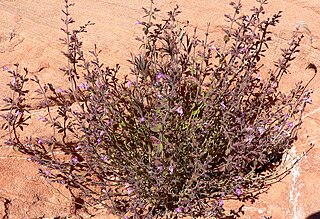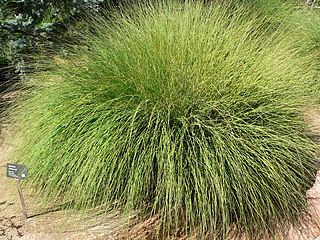
The Celastraceae are a family of 98 genera and 1,350 species of herbs, vines, shrubs and small trees, belonging to the order Celastrales. The great majority of the genera are tropical, with only Celastrus, Euonymus and Maytenus widespread in temperate climates, and Parnassia (bog-stars) found in alpine and arctic climates.

Helianthus is a genus comprising about 70 species of annual and perennial flowering plants in the daisy family Asteraceae commonly known as sunflowers. Except for three South American species, the species of Helianthus are native to North America and Central America. The best-known species is the common sunflower. This and other species, notably Jerusalem artichoke, are cultivated in temperate regions and some tropical regions, as food crops for humans, cattle, and poultry, and as ornamental plants. The species H. annuus typically grows during the summer and into early fall, with the peak growth season being mid-summer.

Dasylirion is a genus of North American plants in the asparagus family, all native to Mexico, with the ranges of three species also extending into the south-western United States. In the APG III classification system, it is placed in the family Asparagaceae, subfamily Nolinoideae.

Purshia is a small genus of 5–8 species of flowering plants in the family Rosaceae which are native to western North America.

Bouteloua is a genus of plants in the grass family. Members of the genus are commonly known as grama grass.

Lippia is a genus of flowering plants in the verbena family, Verbenaceae. It was named after Augustin Lippi, (1678-1705), a French naturalist and botanist. He was killed in Abyssinia. The genus contains roughly 200 species of tropical shrubs that are found around the world. Plants are fragrant due to their essential oils, which vary between species but may include estragole, carvacrol, linalool, or limonene. The leaves of certain species, such as L. graveolens, can be used as a culinary herb similar to oregano.

Neltuma glandulosa, formerly Prosopis glandulosa, commonly known as honey mesquite, is a species of small to medium-sized, thorny shrub or tree in the legume family (Fabaceae).

Canotia holacantha, also known as crucifixion thorn or simply canotia, is a flowering shrub / small tree in the family Celastraceae.

Hedeoma is a genus of flowering plants in the mint family, Lamiaceae. It is native to North and South America. They are commonly known as false pennyroyals.

Helianthella, the little sunflower, is a genus of North American plants in the family Asteraceae.

Muhlenbergia is a genus of plants in the grass family.

Sporobolus is a nearly cosmopolitan genus of plants in the grass family. The name Sporobolus means "seed-thrower", and is derived from Ancient Greek word σπόρος (spóros), meaning "seed", and the root of βάλλειν (bállein) "to throw", referring to the dispersion of seeds. Members of the genus are usually called dropseeds or sacaton grasses. They are typical prairie and savanna plants, occurring in other types of open habitat in warmer climates. At least one species is threatened with extinction, and another is extinct.

Forestiera is a genus of flowering plants in the olive family, Oleaceae. Members of the genus are often called swampprivets. Most are shrubs.

Cleomella is a genus of flowering plants. It includes 22 species of native to North America, ranging from southern Mexico through the western and central United States to western and central Canada. Like their relatives, the cleomes, plants of this genus have traditionally been included in the caper family Capparaceae but have recently been moved into a new family, Cleomaceae. Cleomella are annual wildflowers native to the dry and desert regions of western North America. They are similar to cleomes in appearance. They are erect and branching with leaves divided into three leaflets and inflorescences of yellow flowers with long stamens. Cleomella species are known commonly as stinkweeds or simply cleomellas.
USS Canotia (AN-47/YN-66) was an Ailanthus-class net laying ship which served with the U.S. Navy in the South Pacific Ocean theatre of operations during World War II. Her career was without major incident, and she returned home after the war bearing one battle star to her credit.

The Waterman Mountains are a low mountainous landform in Pima County, United States. Notable among the tree species is the elephant tree which species exhibits a contorted multi-furcate architecture; most of these froze in the cold winter of 2011. The Waterman Mountain range is in the Ironwood Forest National Monument.

Baccharis salicina is a species of plant in the family Asteraceae. Common names include willow baccharis, and Great Plains false willow. It is a shrub found in North America where it grows in mildly saline areas.
Acanthothamnus is a monotypic genus in the family Celastraceae which contains only the species Acanthothamnus aphyllus. The genus is sometimes known by the unaccepted synonym Scandivepres and its natural range spans central Mexico.

Echinopepon is a genus of flowering plants in the family Cucurbitaceae, native to the southwestern United States, Mexico, Central America, and South America. Tendrillate vines, their prickly fruits are operculate, with the prickles themselves being stipitate glandular.
Condalia correllii, also called Correll's snakewood, is a shrub belonging to the family Rhamnaceae.
















